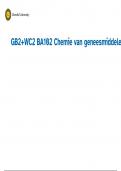Samenvatting
Marketing communications summary
Samenvatting Marketing Communications: a European perspective fifth edition / vijfde editie Patrick De Pelsmacker, Maggie Geuens, Joeri Van Den Bergh ISBN: 9780273773221 Hoofdstukken: 1 t/m 5, 7 t/m 10, 12, 14, 15
[Meer zien]














